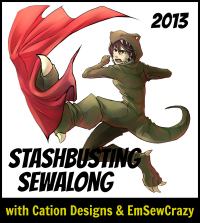ElleC helpfully pointed me towards examples of brightly colored, floral print cottons, especially the work of William Kilburn, and that was enough to convince me that it wouldn't be totally wrong to use the sheet on the left. Besides, there was more white in the fabric, and even though there are examples of non-white-and-poofy Regency gowns, in the end the delicacy of the floral just read more stereotypically Regency to me.
 |
| William Kilburn's floral designs for cottons were definitely brightly colored! |
 |
| An extant gown with a vaguely similar print from the Manchester City Galleries, circa 1795-1800. |
I used a frankensteined amalgamation of the two Regency era dresses in Janet Arnold's Patterns of Fashion; it's the gathered bodice and skirt of the V&A dress and the back and sleeves of the Salisbury Museum dress, combined with the drawstring neckline and closure that was demonstrated on Sense and Sensibility's pattern site. Unfortunately, some aspects got lost in the frankensteining process, and the back is much lower than I intended. The problem with using Cecily as a model is that she has a larger (and less compressible) bust than I do, and that threw off the fit of the bodiced petticoat and the length of my shoulder straps, which in turn caused the bizarre sloping toward the back. This is especially sad since research shows that the backs of the gowns should be higher and smaller, and mine is exactly the opposite -- larger and lower! Ah well, now I know for next time, because you can bet your Regency britches that I'm going to be making another one! Regency dresses are so easy to make and comfortable to wear, and I'm already dissatisfied with my workmanship on this gown, so I'm itching to make another, better one.
 |
| From the Fyeahtheregency tumblr. |
After all my dithering about how the bodice looked, I became pretty dissatisfied with the gown, and it turned into a fairly slapdash effort to finish it up before the Jane Austen Evening. It's almost entirely machine-sewn, even the drawstring channel, and I didn't even bother blind-stitching the hem. The whole thing is unlined, too, so at some point I'm going to need to go back in and either bind or overcast my seam allowances. Anyway, enough disclaimers. Here's what I ended up with for my tea dress!
 |
These pictures were actually taken the day after the tea, since I was in a rush to get out the door on the day of.
|
 |
| I need to fix the bodice of my petticoat, since it's not doing an adequate job of lifting and separating the little I have to work with. |
 |
| Wearing my fichu askew and untucked. You can see here that the back waistline is much lower than it should be. |
 |
| Why do Regency dresses conspire to make the wearer look pregnant? |
The bonnet was also thrown together from materials I already had -- a thrift store straw hat that was originally part of my Ren Faire ensemble, bias tape left over from my hobbit maid costume, a long cream-colored ribbon from my one attempt at being a wedding florist, and fake flowers pulled off of another thrifted hat. I followed this very helpful tutorial to cut apart, line, and re-trim my bonnet.
 |
| I sewed in part of a wire coat hanger to shape the rim of the bonnet. |
 |
| It was mostly hidden by the bonnet's ribbons, but I was also wearing a book locket! |
This outfit is technically part of my Historical Sew Fortnightly sewing queue, so here are the facts:
The Challenge: #2, the UFO challenge, although mine was more of an unfinished idea than an unfinished object.
Fabric: One flat sheet and half of a fitted sheet, twin size, 50/50 poly-cotton blend, apparently from JC Penney's at least a decade ago, if not more. It's been in my stash for two years, so I'm simultaneously stashbusting as well!
Pattern: An unsuccessful combination of two different extant Regency gowns from Janet Arnold's Patterns of Fashion
Year: 1800-ish
Notions: Hooks and eyes, ribbon for the drawstring
How historically accurate is it? Not very. There's the anachronistic materials and construction, and even my attempt to at least use a period pattern was thwarted by poor fitting. At least I tried to do my research for the fabric print, even though I was still trying to make do with what I already had!
Hours to complete: About 12. Even though actually sewing the gown was easy, I spent a while futzing with the pattern pieces and the fit, as well as hand-sewing the inner waistband and the sleeve bands.
First worn: Saturday, January 26, to the tea portion of the Jane Austen Evening.
Total cost: $5 for the sheets, $5 for the straw hat, $5 for a white cotton voile shirt that I cut up and re-sewed to make a triangular fichu, and all the notions were leftover from other projects...all in all, $15 for a fake Regency outfit!
 |
| Zombies are coming! Fly, you fools! Oh wait, that's the wrong story. |








.jpg)






























